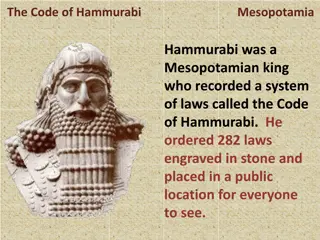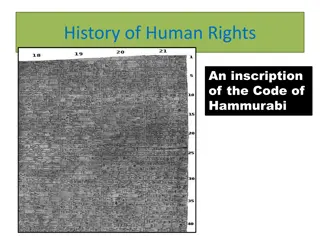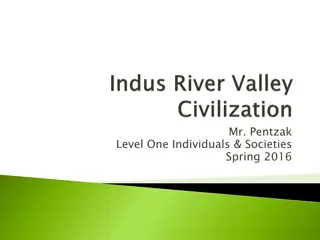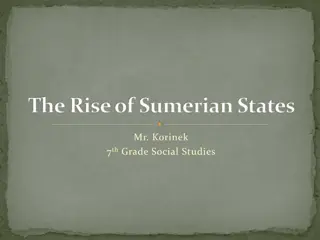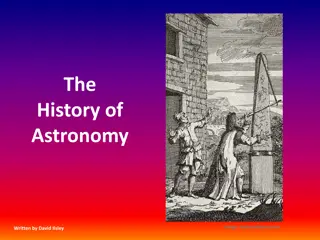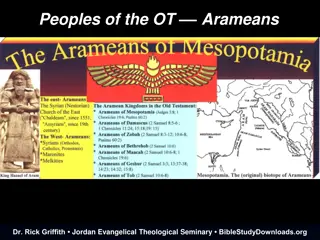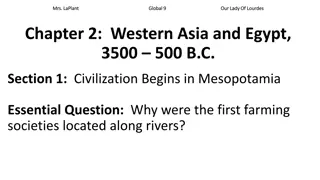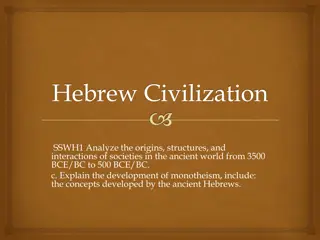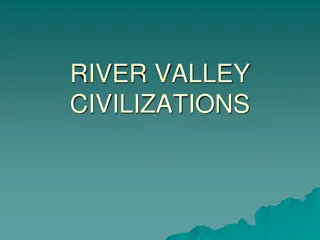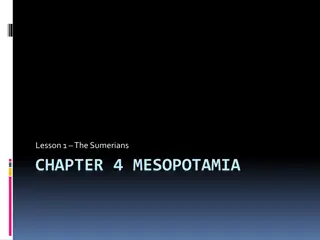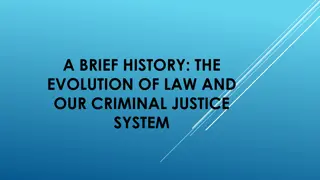VCE History Units 1 & 2 Ancient History Workshop Overview
Explore the implementation of VCE History Units 1 & 2 focusing on Ancient History, including acknowledgment of traditional custodians, overview of study areas, teaching ideas, and key knowledge concepts. Discover the civilizations of Mesopotamia, Egypt, and China with a detailed look at their respec
2 views • 44 slides
The Code of Hammurabi: Ancient Laws of Mesopotamia
Hammurabi, a Mesopotamian king, established the Code of Hammurabi, a set of 282 laws inscribed in stone for public view. These laws included specific punishments for various offenses, famously epitomized by the principle of "an eye for an eye." The code encompassed both criminal and civil laws, shap
5 views • 29 slides
Ancient Origins of Human Rights: Code of Hammurabi to Cyrus the Great
Explore the historical roots of human rights, starting from the Code of Hammurabi in Mesopotamia, through the reforms of Urukagina and the Neo-Sumerian Code of Ur-Nammu, to the groundbreaking principles established by Cyrus the Great in the Achaemenid Persian Empire. Witness the evolution of human r
0 views • 27 slides
Exploring Geometry Vocabulary with Mr. Fiore & Mr. Ryan
Geometry, the study of shapes, has its roots in Ancient Mesopotamia and Ancient Egypt. Concepts such as point, line, ray, endpoint, line segment, vertex, congruent, vertical line, horizontal line, and plane are essential in understanding geometric relationships and structures. This visual guide prov
0 views • 22 slides
Understanding Hammurabi's Code: Rich vs. Poor, Men vs. Women, and Biases
Explore the ancient laws of Hammurabi's Code and analyze how they differentiated punishments based on social status and gender. Learn about the biases of King Hammurabi and how they influenced the legal system he established in Mesopotamia. Delve into the historical context to understand the unequal
0 views • 12 slides
Ancient Civilizations of the Fertile Crescent
Explore the geography and history of the Fertile Crescent, including Mesopotamia, Sumer, and later civilizations like Babylon. Learn about the rich farmland, nomadic lifestyle, irrigation methods, Sumerian achievements in writing, and the rise of empires under rulers like Sargon and Hammurabi.
0 views • 13 slides
Evolution of Cities: From Ancient Origins to Modern Developments
Settlements and cities have evolved over millennia due to factors like geographical obstacles, social divisions of labor, and economic needs. From ancient civilizations in Mesopotamia and Egypt to the urban expansion during the Roman Empire and the Industrial Revolution, cities have grown at locatio
3 views • 15 slides
Ancient Civilizations Studies and Group Activities
Explore the similarities between Mesopotamia and Ancient Egypt, make predictions about another ancient civilization, engage in group activities like reading chapters, answering questions, and playing Vocab Alive. Learn about key terms like Monsoon, Sanskrit, Caste System, and more. Collaborate in sm
0 views • 33 slides
Understanding the Rise of Sumerian City-States in Mesopotamia
Small farming villages in Mesopotamia developed into independent city-states around 3500 B.C.E. These early settlements faced challenges such as food shortages, uncontrolled water supply, difficulties in irrigation, and attacks from neighboring communities. The inhabitants built walled cities with f
3 views • 18 slides
Fascinating Facts About Fragrances
Discover interesting facts about fragrances, from their historical origins in Mesopotamia and Ancient Egypt to their modern-day popularity. Learn about the evolution of perfumes, the manufacturing process, and the potential effects of fragrances on individuals. Explore why some people dislike fragra
0 views • 10 slides
The History of Astronomy: From Ancient Wonder to Modern Science
Astronomy, the oldest science, has fascinated humanity for millennia. From early interpretations of celestial bodies as gods to the development of instruments in Mesopotamia to predict events like eclipses, the evolution of astronomy is rich and diverse. Aristotle's theories on the cosmos laid the f
0 views • 25 slides
Ancient Cultures and Societies: Skills, Reflection, and History
Explore the skills, attributes, and reflections necessary for success, alongside a journey through ancient civilizations like Mesopotamia, Egypt, India, and China. Dive into the rich history of dynasties, societal structures, and cultural exchanges along the Silk Road. Uncover the origins, interacti
0 views • 20 slides
Exploring the Arameans of the Old Testament
Uncover the history and contributions of the Arameans in the Old Testament. Learn about their identity, genealogy, geography, and interactions with other civilizations like Israel. Discover the unique aspects of Aramean culture and their presence in Northern Syria, Upper Mesopotamia, and beyond.
0 views • 46 slides
Early Civilization in Mesopotamia: Sumerian Contributions and City-States
The early civilization in Mesopotamia, particularly the Sumerians, thrived along rivers due to fertile soil from floods and the ease of irrigation. Belief in multiple gods stemmed from harsh climates. Sumerian contributions spanned political, cultural, and technological realms. City-states played a
0 views • 16 slides
Development of Monotheism: Ancient Hebrew Civilization Overview
Ancient Hebrew civilization, emerging around 2000 BC in Canaan, played a crucial role in the development of monotheism through Judaism. Influenced by Mesopotamia and Egypt, the Hebrews introduced monotheistic beliefs, as seen in the key features of Judaism such as the Ten Commandments. The Exodus fr
0 views • 7 slides
River Valley Civilizations: The Birth of Early Societies
Explore the impact of geography and the Neolithic Revolution on the development of River Valley Civilizations like Mesopotamia. Learn about key vocabulary, the rise of civilizations in fertile river valleys, government structures, economies based on agriculture, and religious beliefs in polytheism.
0 views • 48 slides
Civilization of Sumer: Mesopotamia's First Urban Society
Mesopotamia, the cradle of civilization, saw the rise of the Sumerians in 3000 BC. Situated between the Tigris and Euphrates rivers, the Sumerians developed advanced city-states, introducing writing, agriculture, and social classes. Their legacy includes innovations in irrigation, city planning, and
0 views • 10 slides
The Evolution of Law and Criminal Justice Systems Through History
Law and the criminal justice system have evolved over millennia, starting from primitive and ancient times in Mesopotamia and Babylon to the development of court systems in Egypt, China, Greece, Rome, and England. Each civilization contributed unique elements that shaped the foundations of modern le
0 views • 29 slides
Evolution of Monetary Functions: From Ancient Mesopotamia to Modern Economics
Delve into the origins and development of monetary functions throughout history, from the use of silver shekels in Mesopotamia to the complexities of modern currency systems. Explore the evolution of money's roles as a unit of accounting, medium of exchange, store of value, and more, shedding light
0 views • 8 slides
Evolution of Money: From Barter to Coins in Ancient Civilizations
In ancient Mesopotamia and China, various commodities like barley, metals, and cowries were used as currencies before the emergence of standardized coinage. Control over the money supply became essential for political authority, leading to the minting of coins. The surplus production in societies al
0 views • 10 slides
Influences and Development of Egyptian Civilization
Connections between Mesopotamia and Egypt in the Predynastic period influenced the early formation of Egyptian civilization. The unification of Upper and Lower Egypt under Narmer marked the beginning of recorded Egyptian history. The dynastic periods shaped the culture and society of ancient Egypt,
0 views • 25 slides

